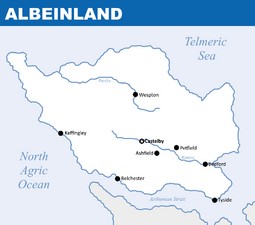Albeinland
This article is incomplete because it is pending further input from participants, or it is a work-in-progress by one author. Please comment on this article's talk page to share your input, comments and questions. Note: To contribute to this article, you may need to seek help from the author(s) of this page. |
Kingdom of Albeinland | |
|---|---|
Motto: Domine, dirige nos "O Lord, direct us" | |
 Albeinland (dark green) in the Lorecian Community (light green) in Lorecia (grey) | |
 Political map of Albeinland | |
| Capital and largest city | |
| Official languages | English |
| Ethnic groups (2010) | See demographics |
| Demonym(s) |
|
| Government | Unitary parliamentary constitutional monarchy |
• Monarch | Catherine II |
| Vincent Lloyd | |
| Legislature | Royal Assembly |
| Establishment | |
| 08 December 1012 | |
| 23 March 1665 | |
| 05 July 1994 | |
| Area | |
• Total | 1,351,200 km2 (521,700 sq mi) |
| Population | |
• 2020 estimate | 31,394,608 |
• 2011 census | 29,283,129 |
• Density | 23.2/km2 (60.1/sq mi) |
| GDP (nominal) | 2020 estimate |
• Total | $1,311,164,408,512 |
• Per capita | $41,764 |
| Gini (2020) | low |
| HDI (2020) | very high |
| Currency | Albish Sterling (ALB, £) |
| Time zone | Albish Central Time (ACT) |
| Driving side | left |
| Calling code | +32 |
| Internet TLD | .ab |
Albeinland, officially the Kingdom of Albeinland, is a country located on the Astyrian continent of Lorecia, sharing borders with Noordenstaat and Fyngaria to the south, Aswick to the east, Arstotska to the northeast, Western Tundra to the north and the Aurora Confederacy to the northwest. According to its last demographic census, the Albish population is comprised of almost 30 million inhabitants, with the majority of them living on major urban centres.
The first known reports of homo sapiens in the territory that today corresponds to Albeinland comes from Arlethic tribes, an ethnolinguistic group that came from the north and east of Lorecia who established their first villages and settlements in the 4th century BCE. Over the years, external contacts made through trade enabled the expansion of some of these tribes, which formed the first kingdoms. From these kingdoms, three of them managed to establish a hegemony over the other kingdoms and tribes of the region: Anglea, Cambrea and Lencester, with its period being known as the Tritarchy. After years of total control, Gaullic invaders from Haguenau led by the House of Annesley set their own settlements on the coast and, after years of intensive conflict, unified the entire Albish territory into one single kingdom in 1012. The Middle Ages were characterized by the expansion of feudalism and relative stability that served as the base for the beginning of the Albish Renaissance, where it was seen major progress on the fields of arts and science. It was also under this time that most of the population converted to Lutheranism and the monarch obtained absolute powers, becoming chief of the state and the church as well.
However, by the start of the 17th century, bigger confronts against royal power that was worsened by the Albish defeat at the Auroran War led to the start of the Magnanimous Revolution, where the liberal aristocracy and the bourgeoisie (the Oxfords) fought against the more traditionalist nobles that remained loyal to Edmund III (the Cavaliers), resulting in a two-year civil war which ended with an Oxford victory that caused the deposition of Edmund and its dynasty out of power and the establishment of the Royal Charter, making Albeinland one of the first constitutional monarchies in the world. The 18th and 19th centuries are known for being a golden era, with the country staying in the majority of the time under a good economic condition and being at the centre of most philosophic and scientific discussions of Lorecia. In the 20th century, Albeinland testified several social advances such as the introduction of universal suffrage and the creation of a welfare state, although it has been suffered severely, both socially and economically, in the general crisis of 1986.
Currently, Albeinland is a developed country with one of the largest economies of the world. Its political system is operated under a unitary parliamentary constitutional monarchy, with its Monarch Catherine II acting as the chief of state while the Prime Minister Vincent Lloyd acts as the chief of government. The national legislature is the Royal Assembly, which meets commons and peers to discuss and approve new laws. Most part of the Albish population lives in urban zones, with Castelby being its capital and largest city. Albeinland is a founding member of the Lorecian Community and is a member of several other international organizations.
Etymology
The name Albeinland comes from the Old English Albaland, which means “land of the Albans.” Although there isn’t any definitive certainty about the origin of the term, its earliest record comes from Gaullic chronicles dated back in the 5th and 6th centuries, which led many to believe that it is an exonym used by Gaullic merchants at the time to describe Albeinland as a whole that became officialized after the invasion and consequent unification of the region by the House of Annesley. Before the invasion, it’s speculated that the natives called the area as Hwiteland. The reasons that could lead the invaders to use this name could come from the harsh Albish winter, which makes the entire landscape be covered in snow, or the very white skin colour of the natives.
Regarding its gentilic, the current official and most used version by the population is Albish and, although its variations Alban and Albian aren’t considered to be wrong, they are rarely used and seen as archaic.


